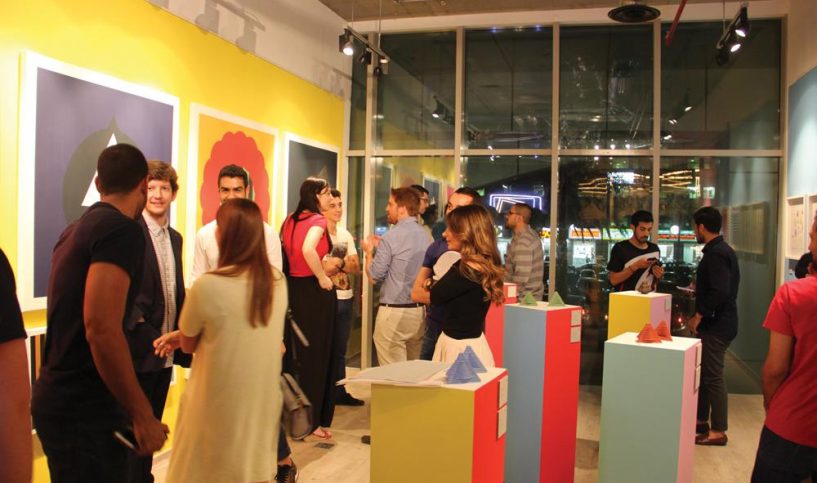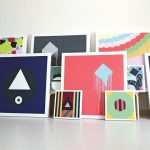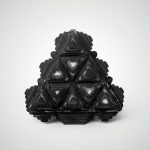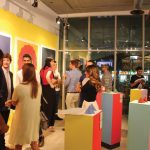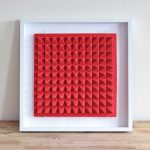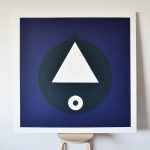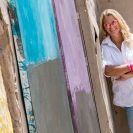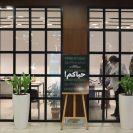Ricardas Blazukas is an eclectic independent artist and professional architect whose work portfolio ranges from abstract painting and photography, to cast sculpture and ceramics. His work, published in UK design magazines and sold on the prestigious Saatchi Art online platform, is best known for his skilled touch and instinctive response to color. His first solo exhibition in Kuwait, “Geometry of Colour,” which ended on the 4th June, opened last month in Almakan’s art gallery to great success, with most of his paintings selling out on the opening night of the exhibition.
Raised in Lithuania, a small country in Northern Europe, to a musical family, Ricardas spent nearly a decade at a leading music school, but his passion for art took over in his early teens when he started attending art school. At an early age he was exposed to a variety of cultures – a Lithuanian up-bringing, Polish schooling and growing up amongst a Russian community, all of which taught him “how to adapt in a multi-cultural society.” He believes this shaped both his artistic and personal identity and sent him overseas to experience more, “I believe for this reason only I decided to move to London as soon as I turned eighteen.” Living in London for seven years, Ricardas undertook architectural studies and grew professionally as an architect designer. He moved to Kuwait nine months ago to work at one of the leading architectural companies in Kuwait, PACE. He says, “I wonder if I would be in Kuwait right now if I wasn’t open to new environments. I think these moments in life are not just a change of location, but also a sort of subconscious influence on my artist’s identity. My work isn’t focused on one culture only, I look for inspiration wherever I can find it.”
Ricardas’ work has been the talk of the town, so bazaar sat down with him to hear more about his vision, inspirations and aspirations.
What got you started in the fields of art and architecture?
I think that my interest in art grew naturally. I never thought I’d be an artist when I was a child. I didn’t know how to draw and believed that only those naturally gifted could be artists. For some reason, I still wanted to get into art school. Whilst there, I remember my painting teacher told me he had no clue how to draw, although he was a great expressionist through his paintings. This gave me confidence in what I was doing at the time. In order to apply for an architecture degree in Lithuania, taking an academic drawing exam is compulsory. I decided to pursue a career in architecture, because I couldn’t see myself on any other pathway.
How do you think your architecture background has also influenced your art?
The architecture degrees which I undertook were very experimental and influenced by art. For example, I spent my last year of the Architecture Master’s degree throwing pots and various odd objects, building my own kilns and firing ceramics. I had great freedom to experiment with architecture through art. People thought I was not focusing on the right things, but I pulled off a distinction for my Master’s Degree Graduation project Ceramics Quarter in Marrakech. Most of my idols that year were artists, such as Jun Kaneko, Ken Price, Peter Shire, James Turrell… I think there is a lot of space for art in Architecture, and vice versa.
Why focus on geometry and color in this latest series?
Geometry is something that I don’t think I will be able to lose in my work anytime soon. I am grateful to have been a student of Design Studio 15 at University of Westminster in London, lead by Sean Griffiths and Kester Rattenbury. For me, this was the best art and architecture school. I was encouraged to work with geometry and I knew right away that it was my thing. I’ve gone through a lot of contemplations about geometry , and what color does to it. There’s something really interesting about the meeting points of two or more geometries. Sculptural form also gives a completely new dimension to geometry.
I have done a lot of work developing the relationship between geometry and color through drawings and sculpture before I came to Kuwait, but at the same time I worked on many of my new ideas here. It was only right to put it all together and show it to people at my current exhibition ‘Geometry of Colour’ at Almakan.
What would you like to convey to people in this series?
I like to offer people abstraction and hear their interpretations of my work. I think this way, the viewer becomes an artist too. The series of paintings which I fully developed in Kuwait is called ‘Intuitive Geometry’. I created them by simply doodling various abstract geometries. These were then taken on to a canvas and drafted with more precision. I enjoy giving people freedom to read what the artworks try to portray. I feel like they attempt to read a message that I subconsciously depicted through my creative process – there is no right or wrong interpretation.
How have people in Kuwait and regionally reacted to your artwork?
There was great interest in my artwork in Kuwait and I’ve had some amazing opportunities to show it to a wider audience. I’ve shown my work in a group show for YourAOK Benchmark event just several months after I moved to Kuwait. Through this show I was lucky to have met the team behind the creative Almakan concept. I also received an opportunity to be a part of K’s PATH exhibition at Boushahri Gallery. I feel that I am getting good exposure and I hope to be able to show my work to a wider audience in the region and beyond soon.
Can you tell us about an event so far which particularly stood out for you?
My first solo show at Almakan. The gallery is small, but very intimate and welcoming. I’m thankful to everyone at Almakan for letting me take complete ownership of the space and curating it just the way I wanted. I had great support from Almakan as well as all other people around me, blogs and various cultural organizations. The opening night was a success with a good turnout and most of my paintings were gone by the end of the night! People were mostly surprised by the work they saw at their doorstep. I’m just happy it all worked out and already can’t wait for the next challenge.
Tell us about your recent exhibition for Artists for K’s PATH?
This was a charity exhibition organized by Shaikha Fatima Al Sabah. I was honored to be invited amongst 24 other great artists to take part in this exhibition. I am delighted that all my paintings sold and I’ve contributed to a good cause. I have met a lot of people and this was another good step towards becoming part of Kuwait’s art community.
I understand you are also a fan of graffiti? Do you have plans to get into this or the street art scene in Kuwait?
Graffiti has been around me since my teenage days. I did a lot of work in Lithuania, as well as London. I’ve met a number of graffiti artists here in Kuwait and I’m sure I’ll leave my mark soon! It’s only a matter of time now.
What’s next for Ricardas Blazukas?
Every now and then, I think about what I would do if I had an opportunity to do a huge mural in Kuwait City. I get really excited and I hope this can happen soon.
I would like to continue participating in shows in Kuwait, but will also look for opportunities to show my work in other parts of the region. Next stop Dubai would be perfect!
Anything else you would like the readers to know?
When I came to Kuwait I was told there was no art scene here. When I started painting I realized that there are so many cool and creative things happening. The scene is definitely buzzing with many things to do every weekend. There are people who are trying really hard to make this happen, but the audience needs to show better interest. I would like to invite everyone to come to exhibitions and various cultural gatherings. Look out for these events, participate and support the community!
Get in touch with Ricardas via ricardas@whycgi.com, follow him on Instagram @ricardasofficial and also check out his personal blog about his creative projects on whycgi.com/ricardas. Lastly, if you see him around, stop and say hi! Opening night image courtesy of Jassim Al-Nashmi. All other images provided by the artist.



